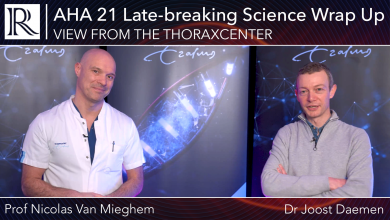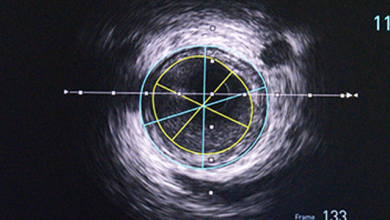Search results
Author(s):
Nicolas M Van Mieghem
,
Joost Daemen
Added:
2 years ago
Learn more about of the top AHA 2021 late-breaking trialswith View from the Thoraxcenter hosts, Professor Nicolas Van Mieghem and DrJoost Daemen (Thoraxcentre, Erasmus MC, Rotterdam, NL). In this short summary video, they summarise the take-home messages and share their take on how the data will shape patient care and research.
Trials covered in detail include:
• Aortic Valve Replacement versus…
View more
Author(s):
Michael F Morris
,
Philip A Araoz
Added:
3 years ago
Mitral valve dysfunction is the most common cause of valvular disease in the US.1 Although echocardiography is the primary non-invasive modality for visualizing the mitral valve, advances in technology continue to allow for improved evaluation of mitral disease with magnetic resonance imaging (MRI) and computed tomography (CT).2,3 Currently, the role for MRI and CT assessment of the mitral valve…
View more
Role of IVUS in Complex PCI
Author(s):
Brandon Quintana
,
Akram Ibrahim
Added:
3 years ago
Article
Author(s):
Yury Malyshev
Added:
2 months ago
AF Symposium 24 — Dr Yury Malyshev (Mount Sinai Hospital, US) joins us to discuss the findings from three studies focusing on the long-term effects of pulsed-field ablation (PFA) on coronary arteries.QuestionsWhat is known currently about the effect of PFA in Coronary Arteries? What is the importance of this topic?What was the study design and cohort?What are the key findings?Who are the take…
View more
Author(s):
Fay Lin
,
James K Min
Added:
3 years ago
Cardiovascular disease (CVD) afflicts greater than 70 million patients in the US alone, and accounts for over half of all deaths. Non-invasive cardiac imaging modalities are used to provide enhanced methods of diagnosis of CVD, guidance of patient-specific therapy, and prognostication of cardiac-related risk.
Non-invasive cardiovascular imaging has traditionally been stratified into two distinct…
View more
Author(s):
Marcelo F Di Carli
Added:
3 years ago
Positron emission tomography (PET) has contributed significantly to advancing our understanding of heart physiology and pathophysiology for more than 25 years. Despite its clear success in research applications, the restricted availability of this technology, its increased cost and limited data supporting its use and reimbursement have all contributed to the relatively limited clinical acceptance…
View more
Author(s):
Jeffrey M Schussler
Added:
3 years ago
Cardiac computed tomography (CT), and in particular computed tomographic coronary angiography (CTCA), stand poised to revolutionize the way in which cardiac pathology is diagnosed, and change the way in which decisions are made with regards to invasive treatment of cardiac disease. In particular, the diagnosis of coronary disease (the number one killer of patients in modern societies) will be…
View more
Author(s):
Raoul Bonan
,
Anita W Asgar
Added:
3 years ago
Coronary angioplasty has revolutionized the treatment of coronary artery disease. Over the past two decades the field has seen numerous innovations in an attempt to perfect the percutaneous management of coronary atherosclerotic disease. The development of coronary stenting was a major advance in preventing elastic recoil and treating dissections following balloon angioplasty.1 Unfortunately,…
View more
Author(s):
Santiago Garcia
Added:
1 year ago
TCT 22 - Dr Santiago Garcia (Minneapolis Heart Institute at Abbott Northwestern Hospital, MN, US) joins us to discuss the findings of a substudy of the PARTNER 3 Trial which aimed to evaluate the safety and efficacy of Edwards' SAPIEN 3 Ultra transcatheter heart valve in aortic stenosis patients with a failing bioprosthetic valve.
In this study, 125 patients received TAVR using the Sapien 3…
View more
Author(s):
Morton J Kern
,
Katherine M Yu
Added:
3 years ago
Coronary artery disease (CAD), the most common cause of morbidity and mortality in the US, is frequently identified by coronary angiography. Decisions for treatment are often based on angiography alone, absent other clinical indicators for intervention. However, by angiography alone, conventional wisdom has suggested that a coronary stenosis is significant if there is at least a 50 % diameter…
View more













 « First
« First